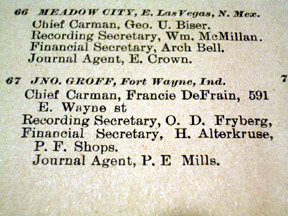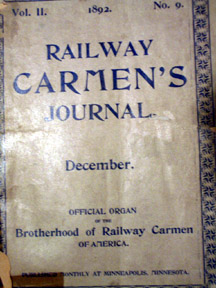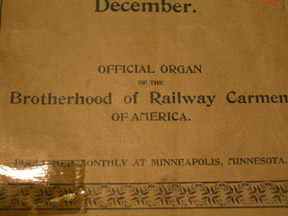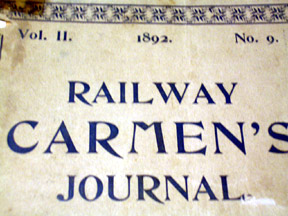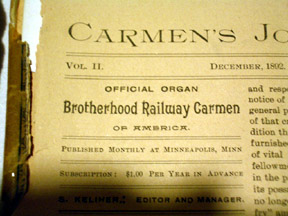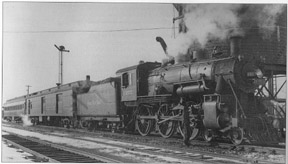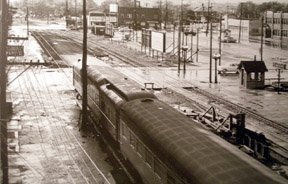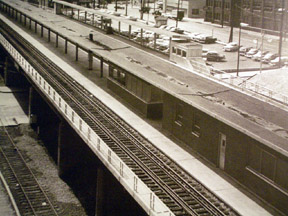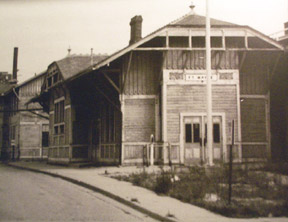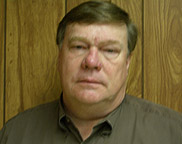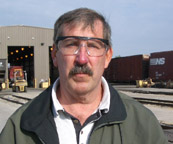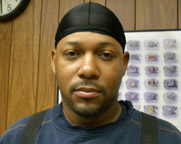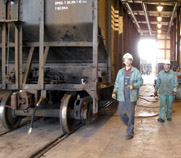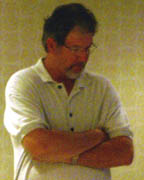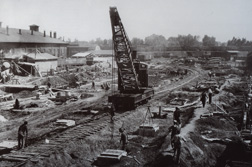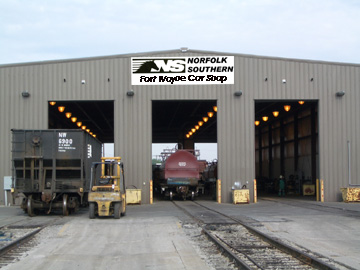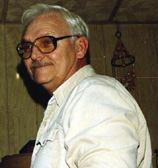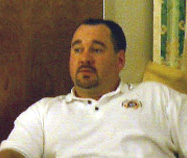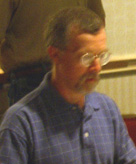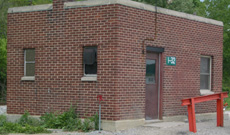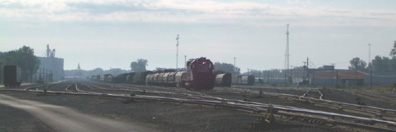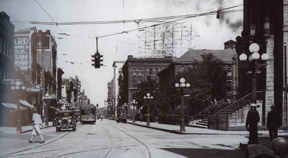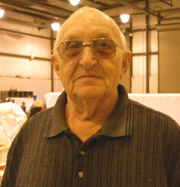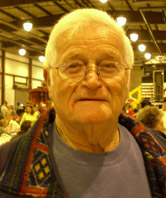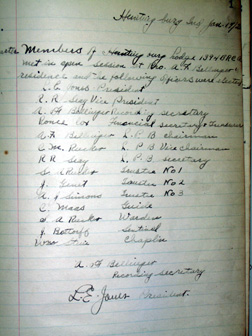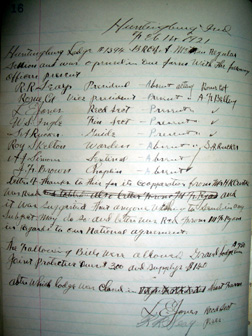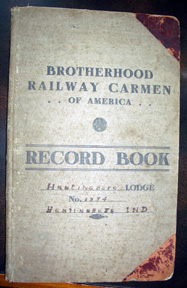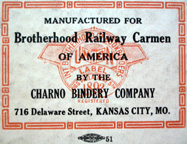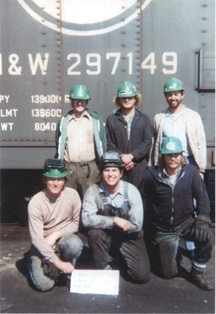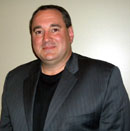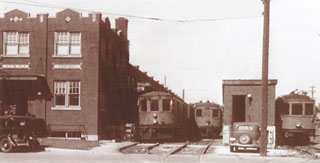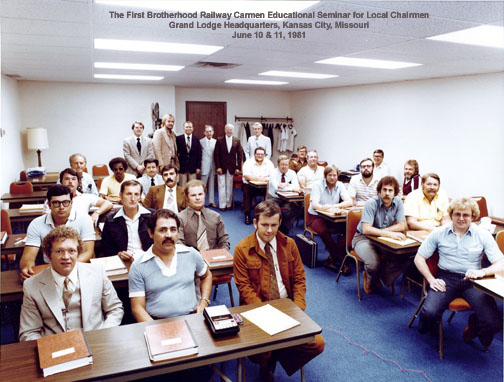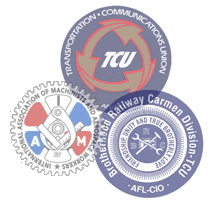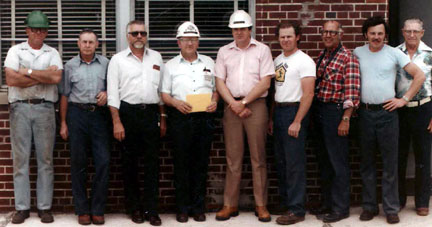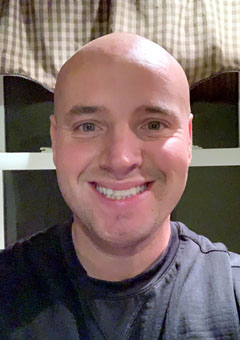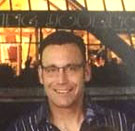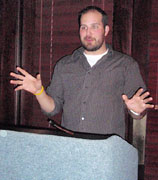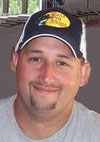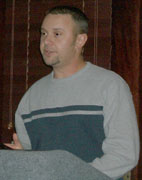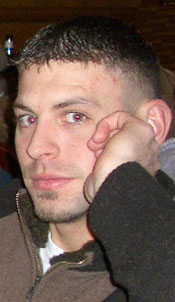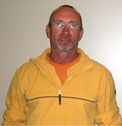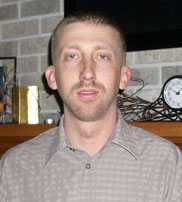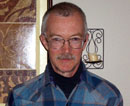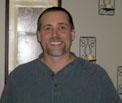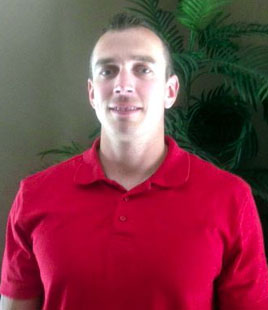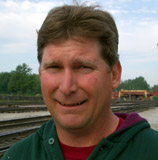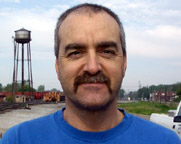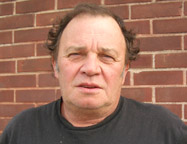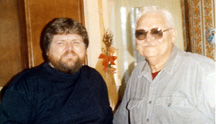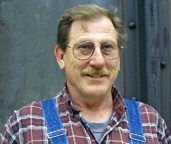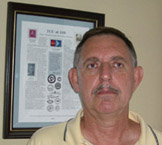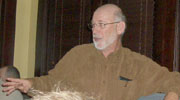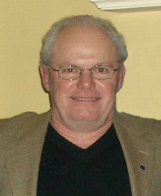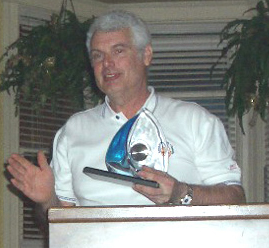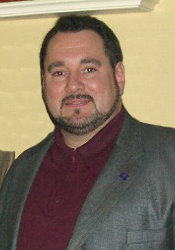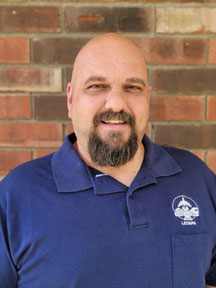The History of Heartland Lodge 6760
Indiana became the 19th state in the union in 1816. In those days pioneer travel in Indiana was laborious. By 1830 an 86-mile stagecoach line was established between Indianapolis and Madison, the trip took anywhere from 2 to 5 days, it was unreliable and dangerous. The ride was rough, wheels splintered or broke, coaches got stuck in mud.
People did not travel much in those days, except when moving. A modern transportation network was critical if Indiana was to become part of the regional and national economy. In 1830 there were 24 state highways. These highways were merely cleared dirt trails that became impassable in wet weather. Boat travel was slow and rivers did not reach most of the state. Railroads were cheaper to build and could reach places where canals could not be built.
In 1832 Indiana chartered eight railroads. Unfortunately, all of them failed, until the 1850s. New technology that incorporated steel rails instead of wood permitted reliable rails for train-travel and increased Indiana's rail miles from 240 to 1,400 miles by 1854. By 1860 over 2,000 miles of new steel rails covered Indiana, ranking the state fifth in the nation in railroad mileage. By the beginning of the Civil War 71 of Indiana's 92 counties had rail service.
The completion of the Ohio & Indiana Railroad to Fort Wayne in 1854 created Indiana's first rail link to the East from Chicago to New York. This rail network brought jobs to the area, and the birth of our craft began.
Brotherhood Railway Carmen Lodge 6760
Our labor craft roots began in the mid-1850s as railroads developed, more crafts were needed to ensure safe and more reliable train travel. Inspectors and car repairers became an important part of railroading. It took about 35 years of being overworked, underpaid, with no benefits, no retirement, no rest days before our forefather's began to organize and form labor unions. Nationwide railroad unions began as early as the 1870s. One group of the Brotherhood of Railway Car Repairers of North America organized in 1888. Another group named the Brotherhood of Railway Carmen of America organized in 1890. The car inspectors and car repairers in Fort Wayne organized two years later and affiliated with the Brotherhood Railway Carmen of America becoming Lodge 67.
The history of Lodge 6760 dates back to 1892. The lodge was originally chartered with the Brotherhood Railway Carmen of America as the John Groff Lodge No. 67, located in Fort Wayne, Indiana. Details of the early lodge history are uncertain, however, the lodge is listed in the union's monthly magazine the Railway Carmen's Journal, Official Organ of the Brotherhood Railway Carmen of America, Volume 2, No. 9, dated December 1892. The Railway Carmen's Journal was then published by S. Keliher, Grand Secretary and Treasurer, 301 to 303 Rochester Block, Minneapolis, Minnesota.
Printed in the 1892 Directory of Lodges is: "Lodge 67, JNO. Groff, Fort Wayne, Ind., Chief Carman, Francie DeFrain, 591 E. Wayne St. Recording Secretary, O. D. Fryberg, Financial Secretary, H. Alterkruse, P. F. Shops. Journal Agent, P. E. Mills."
The cover of Volume 2, Issue 9, of the 1892 edition of the Railway Carmen's Journal
Listed In the directory of lodges is the John Groff, Fort Wayne, Indiana Lodge No. 67
A close-up of the top portion of the cover of a 1892 issue of the Railway Carmen's Journal
A close-up of the bottom portion of the cover of a 1892 issue of the Railway Carmen's Journal
In 1892, the Railway Carmen's Journal was published by S. Keliher, Grand Secretary and Treasurer, 301 to 303 Rochester Block, Minneapolis, Minnesota.
Shortly after the Railway Labor Act became law, another group of Carmen in Fort Wayne, Indiana, led by Henry R. Martin obtained a new charter with the Brotherhood Railway Carmen of America at Fort Wayne. In January 1936 the Local Lodge at Fort Wayne received its new charter with the union as Lodge 760 and Henry R. Martin became the lodges first Local Chairman. Officers are elected to three-year terms.
Since the modern era of the lodge, which began in 1936, Fort Wayne Lodge has had 14 Local Chairmen who have handled all contractual and representational matters for the membership. Over this same time period the lodge has had 20 Presidents who have governed over meetings and direction of the lodge. These and other officers along with their corresponding dates in office are listed below in the Past and Present Officers Section.
Union Mergers and Consolidations
Since 1936 several consolidations have occurred involving the lodge. In 1965 members of the Wabash Lodge at Fort Wayne merged into Nickel Plate Lodge 760 at Fort Wayne.
In 1980 eight of the lodge's members at South Bend, Indiana were furloughed when the shops were closed. All of these members elected to receive a severance package negotiated under the provisions of the Washington Job Protective Agreement.
In November 1982 the Peru, Indiana shops were closed, some of the members of the Peru, Indiana Lodge merged into Lodge 760.
In September 1984, the Montpelier, Ohio shops were closed and all but three of those members were transferred to Fort Wayne Lodge.
In May 1985 the Lima, Ohio shops were closed. In its heyday Lima employed over 300 Carmen. When it closed the seven remaining Carmen were transferred to Fort Wayne. Also, in May 1985 Argos, Indiana was closed and its sole remaining Carman elected to receive a severance package negotiated under the provisions of the Washington Job Protective Agreement.
In 1986, Carmen voted to merge with BRAC, which formed TCU. Members in the craft today are part of TCU's Carmen Division, which operates under its own By-laws. The Division President serves on the Executive Council as an International Vice President of the full union. In addition, one of the Division's top officers is selected at their convention to serve as a member of the union's Board of Trustees. As a result of the BRC-BRAC merger Fort Wayne Lodge 760's name and Lodge number were changed to Brotherhood Railway Carmen Division of TCU, Fort Wayne Lodge 6760.
In 1988 the members of the Frankfort, Indiana Lodge were merged into Fort Wayne Lodge. These members were subsequently transferred to the Lodge in Decatur, Illinois after Frankfort was closed in 1997 and the Carmen resumed employment at Lafayette, Indiana.
In January 1991, Carmen employed at Muncie, Indiana were transferred into Fort Wayne Lodge. Today, two of these Carmen still remain at Muncie under the jurisdiction of Lodge 6760.
From 1936 to 1993 Fort Wayne Lodge 6760 was a member of the Nickel Plate Joint Protective Board No. 350. In its heyday Joint Protective Board 350 boasted 35 local lodges. By 1993 there were only six remaining lodges Chicago, Illinois; Bellevue, Toledo, Ohio; Greenville, Pennsylvania; Flatrock, Michigan; and Fort Wayne, Indiana. Due to declining membership the Nickel Plate Joint Protective Board 350 was merged into the Finlay Lines Joint Protective Board 200 April 1, 1993. By the action of the delegates during the 1997 Convention, the Finlay Lines Joint Protective Board changed its name to the Norfolk Southern Joint Protective Board No. 200. At the 40th and last Joint Protective Board 200 Convention in 2005, with the recommendation of the General Chairman, delegates and officers voted 16 to 2 to surrender the Board's Charter and turn over its $1.2 million treasury to the Grand Lodge and become Unit 200, under the direction of the Grand Lodge. In 2020 Unit 200 was closed and was merged with Unit 410.
In April 2000, four active lodges, comprising of eight former lodges located at Detroit, Michigan; Columbus, Cincinnati and Portsmouth, Ohio; Louisville and Danville, Kentucky; Kenova, West Virginia; and Huntingburg, Indiana were merged into Lodge 6760.
In January 2001, our members employed at Kenova, West Virginia were transferred into Lodge 6454 at Williamson, West Virginia, as they work much closer to the Williamson Lodge. This transfer permitted those members easier access to the lodge headquarters.
In 2011 TCU members employed by the Union Tank Car Company in Marion, Ohio and members employed by Road and Rail Services near Roanoke, Indiana joined lodge 6760.
August 22, 2012, Lodge 6760 changed its name from Fort Wayne Lodge to Heartland Lodge to reflect the geographical transition the lodge has experienced over the past 11 years. At that time the lodge represented over 500 members in 15 cities, covering four states. The name change was approved along with other amendments in the Lodge By-Laws by TCU President Robert A. Scardelletti.
In 2016 Carmen employed at UTLX were transferred from Lodge 6760 and formed a new charter at Marion, Ohio.
In 2020 Lodge 6760 was transferred from TCU Unit 200 to Unit 410, under the jurisdiction of National Representative Jason Cox.
In 2021 Huntingburg, Indiana shop was closed. Those members were transferred to Louisville, Kentucky. In May 2023 the Huntingburg, Indiana Shop was re-opened and the members who were transferred to Louisville were moved back to Huntingburg.
On May 14, 2024, the name of the lodge was changed again to recognize the service and successes achieved during the nine-term tenure of Local Chairman Steve Pequignot. With the approval of the lodge membership and TCU National President, the lodge was renamed Steven L. Pequignot Heartland Lodge 6760 Brotherhood of Railway Carmen Transportation Communication Union International Association of Machinists affiliated with the AFL-CIO.
Lodge Jurisdiction
Today, Lodge 6760's members are employed by Norfolk Southern Railway, Road & Rail Services and Indiana Railroad. Our members inspect, test and repair railway freight cars at Detroit and Milan, Michigan; Montpelier, Columbus, Cincinnati, Portsmouth and Marion, Ohio; Ludlow, Lexington, Danville and Louisville, Kentucky; Linton, Muncie, Roanoke and Fort Wayne, Indiana. The lodge also holds jurisdictional rights on Norfolk Southern property at Indianapolis, Peru, Frankfort, Tipton, Argos and South Bend, Huntingburg, Indiana and Lima, Ohio.
Lodge Tragedies
During its history three members of the lodge have been killed in the line of service. In 1968, Apprentice Carman James Ward was killed at Fort Wayne, Indiana while securing a semi trailer on a TOFC rail car at the East Wayne TOFC storage track. In 1971, Carman Hank Gensic was killed when he fell on the gauge of the rail from a moving freight car at the Fort Wayne Wabash Yard. In 2002, five years after transferring from Lodge 6760 to Lodge 6277, Carman David Fleischhaurer was killed while working under a jacked freight car, the car fell from the jacks at the Frankfort, Indiana train yard.
Another tragedy occurred in 1974, then Lodge Recording Secretary Joe Kady's home was totally destroyed by fire. All of the lodge's records dating back over 80 years were lost forever, including the only copy of the original lodge charter. This loss was nothing compared to the loss of Joe's son Steven Kady. Steven Kady just began his career as an Apprentice Carman at Fort Wayne and a member of this lodge when he perished in the house fire.
Lodge By-laws
As provided in the Constitution, lodges are permitted to incorporate their own By-laws. Lodge 6760 first wrote its By-laws in 1953. Since then the By-laws have been amended 14 times through 2020, all, of which were approved by the BRC and TCU Presidents.
History of the Railroads Employing Members of Lodge 6760
Nickel Plate
The mainline of the New York, Chicago & St. Louis Railroad (aka The Nickel Plate) was completed through Fort Wayne in 1882. It was built atop the old Wabash & Erie Canal that passed through downtown. The original yard was on the west side of town, just west of the St. Mary's River. In 1951 the East Wayne Yard was built in New Haven and the old yard was closed. The line today is Norfolk Southern's Chicago District. The other Nickel Plate line in Fort Wayne was the Lake Erie & Western which entered from the south. It was completed in 1870 and acquired by the Nickel Plate in 1922. Today this line is part of Norfolk Southern's New Castle District. The track elevation through downtown Fort Wayne on the mainline was completed in 1955. Today the dedication plaque on the overpass at Calhoun Street still stands.
The acquisition of the Lake Erie & Western Railroad in 1922 united Nickel Plate with the railroad it had been built to complement forty years earlier. The Lake Erie & Western's Sandusky to Peoria mainline started in Ohio with the Fremont & Indiana Railroad Company on April 22, 1853. The Fremont & Indiana was incorporated to build a line from Fremont southwest towards the Indiana State line. As years passed, more trackage was laid and through acquisitions the line was completed in 1888.
Crossing the LE&W at Tipton, Indiana was a line that extended from Indianapolis to Michigan City, Indiana. This line became part of the LE&W on April 8, 1887. Built by the Peru & Indianapolis, which was incorporated in Indiana on January 19, 1846, this was the first and oldest trackage on the Nickel Plate System.
Another LE&W branch was a line that extended from Fort Wayne, through Muncie to Connorsville. At New Castle a line split off to Rushville. This trackage was acquired by the LE&W in 1890. The portion of that trackage at Fort Wayne connects with the east-west line from Chicago to the east is where our forefathers first chartered the Brotherhood Railway Carmen of America Lodge 67, now known as Lodge 6760. The LE&W shops were located just north of the mainline, now referred to as the Chicago Main at the abandoned West Wayne Yard between Van Buren Street and Runnion Avenue in central Fort Wayne.
In 1895, the LE&W leased the Northern Ohio, a line that extended from Akron to Delphos, Ohio. This line, which eventually became the Akron, Canton & Youngstown, was omitted from the LE&W-NKP consolidation.
The Lake Erie & Western, itself, became part of the New York Central System in 1900. The LE&W was operated as a separate entity throughout its association, never integrated into NYC operation. After the Van Sweringens acquired the Nickel Plate, the New York Central sought to unload the LE&W, so the Nickel Plate and the LE&W were finally united.
The Lake Erie & Western Railroad gave the Nickel Plate another gateway -- Peoria. The Fostoria to Frankfort portion became a vital link in the latter day freight operations. The LE&W, largest of Nickel Plate's four components, became to the Nickel Plate what it had never been to New York Central -- an integral part of a well-run railroad.
Origin of the Name Nickel Plate Road
As told by former president of the NYC&STL Railroad Company, Lynne L. White. The following is an excerpt from the book "The Nickel Plate Road, A Short History of the New York, Chicago & St. Louis R.R." printed in 1954. The book is a record of an address given by Mr. White to the Newcomer Society in North America, held in the ballroom of the Hotel Lawrence, Erie, Pa., November 11, 1954. Mr. White was the guest of honor at this "1954 Lake Erie Dinner."
"Through northern Ohio, already served by four railroads, location of the line developed intense rivalries among cities. Three routes were surveyed and communities along each proposed route vied in the raising of public subscriptions to donate rights-of-way. The road's general offices at Cleveland frequently were besieged by delegations hoping to bring about the routing of the line through their communities. During these inter-city rivalries was born the nickname for the New York, Chicago and St. Louis - The Nickel Plate Road - which rapidly became the name most commonly used.
Numerous legends have grown about when and how the name "Nickel Plate" was first applied. The accepted version is that it appeared first in an article in the Norwalk, Ohio, Chronicle of March 10, 1881. On that date the Chronicle reported the arrival of a party of engineers to make a survey for the "great New York and St. Louis double track, nickel plated railroad."
Later, while attempting to induce the company to build the line through Norwalk instead of Bellevue, Ohio, the Chronicle again referred to the road as "nickel plated" - a term regarded as indicative of the project's glittering prospects and substantial financial backing.
In 1882, the Nickel Plate recognized F.R. Loomis, owner and editor of the Norwalk Chronicle, as originator of the term and issued him Complimentary Pass No.1.
Thus Norwalk named the road - but Bellevue finally got it."
This photo of NKP locomotive 156 was taken in December 1934, the same month Lodge 760 was re-chartered
A photo of downtown Fort Wayne in 1934
taken from Calhoun and Lewis Streets looking north
Wabash
The Lake Erie, Wabash and St. Louis Railroad built a line from Toledo through Fort Wayne in the 1850's and it ran parallel to the Wabash & Erie Canal, passing through Woodburn and New Haven. For awhile, the Wabash used the Eel River Railroad between Logansport and Butler to get to Detroit. When the Wabash was no longer allowed to use the Eel River Railroad they built their own line between New Haven and Butler, completed in 1902. The Wabash depot in Fort Wayne on Grand Street between Calhoun and Harrison Streets, located on the south side of the tracks was torn down in the 1980s. One of the old stairways up to the platform still stands. The Wabash line today is Norfolk Southern's Huntington District and uses the "new" section between Butler and New Haven. The original Wabash line east of New Haven is the Norfolk Southern Woodburn Branch up to Woodburn. East of Woodburn it is operated by the Maumee & Western Railroad, a short-line carrier.
A photo of the Nickel Plate main track in downtown Fort Wayne prior to the 1955 elevation project.
A photo of the old Nickel Plate Depot in downtown Fort Wayne just prior to its razing in 1969.
A photo of the new elevated Nickel Plate Depot in Fort Wayne after its opening in October 1955.
Members of Lodge 760 worked at these three locations, inspecting, testing and repairing passenger cars until Nickel Plate passenger service ended in 1959. After which, the members transferred to the 8-year old East Wayne freight train yard, located 4 miles to the east near New Haven, Indiana.
President
Phil Amadon
2005 - 2010
Financial Secretary-Treasurer
Lowell Wheeler
1990-2008
Retired 2008
President
Gene Carter
1993-2005
Retired 2013
Vice President
Kym Seslar
1992-2007
Recording Secretary
and Board of Trustees Member
Dan Freds
2004-2008
Treasurer
Chuck Browning
1975-1979
Retired 2013
Financial Secretary
Dave Moore
1989-1990
Retired 2010
Chairman Board of Trustees
Donnie Melton
1995-2008
Retired 2008
Outer Guard
Lovelle Cooper
2002-2005
The Carmen at Fort Wayne Shop repaired rail cars outside from 1891 until the new Fort Wayne Car Shop was opened in May 1994.
Members Kevin Hite and Shawn Fensler repairing a NS coal car in the shop.
Local Chairman
Steve Pequignot
1978-2005
Retired 2009
Local Chairman Emeritus 2024
Local Chairman
Steve Wilhelm
2005 - 2009
Promoted to
International Assistant Representative 2009
Promoted to Executive Director
Constitution & Laws 2012
Promoted to
TCU/IAM Chief of Staff 2023
Board of Trustees Member
Gary Gibler
2004-2006
Retired 2012
Past Local Chairman of
Danville, Kentucky Lodge &
Past Assistant
Local Chairman Phil Graham
Past Senior Assistant Local Chairman
Jim Gambill
Retired 2009
Past Local Chairman of Louisville, Kentucky Lodge & Past Vice Local Chairman Paul Jackson
Past Local Chairman of Huntingburg, Indiana Lodge & Past Vice Local Chairman
Larry R. Atkins
Retired 2008
A photo of the Wabash yard being built in Fort Wayne, Indiana in the early 1900s. The Round House is on the left.
Father & Son officers. In 1987 & 1988, Robert White (left) was President and his father Rex White (right) was Recording Secretary. Photo courtesy of Robert P. White, Sr.
It appears the lodge was named after John Groff. In those days it was common to abbreviate first names. The abbreviation of JNO. for John, was commonly recognized in the 1800s. The Brotherhood Railway Carmen of America was formed September 9, 1890 and Lodge 67 was an affiliated lodge of that Brotherhood by December 1892, we can assume that the Fort Wayne Lodge was the 67th lodge to join the Brotherhood sometime between 1890 and 1892. At the present time, it is unclear who John Groff was and why the lodge was named in his honor. Research is still being done on John Groff, we hope to have some information about him available in the near future.
Lodge 67 held its charter until 1900. it is not known why the lodge lost its charter after only eight years. Between 1922 and 1934, unions were band by the government as a result of the disastrous railroad shopmen's strike. In June 1934, rail workers won a victory as President Roosevelt signed legislation strengthening the Railway Labor Act. The amendments established National Adjustment Boards with awards enforceable in court; company unions were outlawed; and a new National Mediation Board was created.
Railroad Mergers
Since the early days of railroading, mergers and consolidations have played an important role in the development of our nation's rail system. The influence of larger and more powerful carriers always has been a major factor in the growth and stability of the smaller railroads. The greater Nickel Plate Road was a result of the consolidation of the Lake Erie & Western and the Clover Leaf with the original Nickel Plate in 1922. Each of these roads were the results of earlier consolidations and mergers.
In the late 1950s, the greater Nickel Plate found itself in a precarious competitive position. The powerful eastern rail giants were lining up in their respective merger positions. To the Nickel Plate, the potential merger of the New York Central and the Pennsylvania forecasted competitive and financial disaster. The Nickel Plate would have to find a powerful ally to assure itself of a strong position in the merger conscious East.
The Norfolk & Western Railway, looking for a way to extend its coal carrying to the Midwest, became that ally. The merger of the Nickel Plate and the Norfolk & Western could be a benefit to both railroads and develop a strong Midwest to tidewater rail system carrying a broad base of commodities.
The prospect of a Nickel Plate-Norfolk & Western alliance put the Wabash Railroad in the same position as the Nickel Plate had been; that of a competitive orphan. The N&W, an expert in the operation of parallel lines since its acquisition of the Virginian Railway in 1959, made no objections to adding the Wabash.
With the ultimate acquisition of the Pennsy's Sandusky Line as the connection between the Nickel Plate and the Norfolk & Western, the Akron, Canton & Youngstown and the Pittsburgh & West Virginia railroads were forced to ask for inclusion in the new system. After more than four years of hearings and planning, the merger became a reality on October 16, 1964.
A subsequent rail merger between Norfolk & Western and the Southern Railway in 1982, renamed the railroad once again. The new name created by the two lines was Norfolk Southern Railway. Thirteen years later, Norfolk Southern made a bold move to purchase 58% of the National Rail Corporation commonly referred to as Conrail after a bidding war with its east coast rivals CSX.
Shortly after the purchase was approved by the Surface Transportation Board, NS experienced major traffic problems running the combined NS/Conrail lines. Business fell, stock prices dropped, many jobs were lost. It took NS five years to regroup. Finally, business returned and by 2004 Norfolk Southern was back on track, stock prices rose, new employees were hired and the railroad prospered.
Organized Labor Movement
Organized labor became a national trend, and Fort Wayne was once again in the forefront. Workers fed up with conditions while owners made millions started was a big push to organze in the late 1800's. The first strike in Fort Wayne came with the Great Railroad Strike of 1877. The strike began in the east, but soon reached the workers of the Pittsburgh, Fort Wayne, and Chicago in Fort Wayne. Tension seemed to boil when Fort Wayne Mayor Charles Zollinger and Railroad managers told the workers to end their protests. The rioters proceeded to take a locomotive and attach it to a caboose the strike leaders were using as a headquarters. The Railroad along with police took the locomotive back and locked it up in a roundhouse until the strike was resolved. It was this group of Railroad strikers that formed the first Union in Fort Wayne, the Brotherhood of the Rootboard chartered in 1863.
Women join the ranks
On July 12, 2004, the first woman began training as a Student Carmen in Lodge 6760, and on September 9, 2004, Tracy Kruzmanowski became the first active female member in the lodge employed at Detroit, Michigan. Today, the lodge has four female members. The lodge looks forward to these advances and encourages our female members to share their ideas and concerns by becoming active in lodge functions.
To our members and officers, past and present
Lodge 6760 has survived over 128 years due to the hard work and solidarity of its members, and through the leadership and dedication of its officers. Our members come from a diverse history. What use to be many railroads and at least ten local lodges are now one, expanding a four-state area. This gives us the opportunity to network our skills and to better protect our members' future.
Members' Contributions to Railroading
Several members of the lodge have been instrumental in the development of railroad equipment in use today. In the early 1970s Lodge 6760 officer and Carman Rex P. White, Sr. developed the rubber chain snubber. It was first used at the old International Harvester loading facility at the East Wayne Yard in Fort Wayne. Brother White spent almost one year using different types of rubber devices clamped in-line to the tie-down chain assemblies used by the railroads to secure highway trucks to railroad flat cars. This rubber device named 'snubber' acted as a cushioning device to absorb shock during rail transit and prevented chain breakage. Brother White was acknowledged as the chief developer of the snubber by N&W Master Mechanic Charles Graham.
Carman & Past Recording Secretary
Rex P. White, Sr., retired in 1987. Photo courtesy of Robert P. White, Sr.
In the 1970s Carman Welder Mac Stauffer invented the retractable blue flag stand. This device is installed between the rail gauge, mounted on a rail tie. When not in use the stand with a blue flag mounted at the top is retracted on the ground. When in use the stand is raised 90 degrees and locked in place vertically, displaying the blue flag. Blue flags are used by mechanical employees in conjunction with a blue lock to ensure no movement will take place on the track blue flagged while rail cars and locomotives are inspected, tested or repaired. Brother Stauffer's invention was first used at Lima, Ohio in the early 1970s. When Lima closed in 1985, Mr. Stauffer transferred to Fort Wayne and brought his invention with him. When he retired in 1993, every yard track and repair track was equipped with one of his retractable blue flag stands. Brother Stauffer's design for the blue flag stands is still used today.
In 1986 Brother Mac Stauffer invented "Rambo." Rambo is a jack stand used to jack freight car center sills in the draft position so repairs could be done to the center sill. Rambo, has four small rail wheels and is made of steel construction with a jack receiving plate to mount a jack horizontally. Rambo is secured to a rail car, when the jack attached to Rambo is activated, it forces the center sill outward on the opposite end of the car so repairs can be performed.
Members of the Lodge elected as Joint Protective Board Officers
Lodge 6760 was pleased to have one of its members elected as General Chairman. In 1957 General Chairman Frank Pugsley, from Lima, Ohio retired. Vice General Chairman Samuel Campbell, from Fort Wayne, succeeded to the office of General Chairman of the New York Chicago & St. Louis Joint Protective Board (later known as the Nickel Plate Joint Protective Board). General Chairman Campbell was elected to the office of General Chairman in 1959 and held that office through 1963.
Members' Contributions to the Union
Lodge 6760 may not have existed without the determination of one man, Henry (Hank) Martin. Shortly after President Roosevelt signed into law the improved Railway Labor Act, Hank Martin contacted the Brotherhood Railway Carmen of America Grand Lodge with the necessary signatures petitioning for a new charter at Fort Wayne. In January 1936 the Carmen at Fort Wayne received their charter. Hank Martin served as a union officer of the lodge for the next 27 years, until his retirement in 1962. Brother Martin served 12 years as the lodge's first Local Chairman, then served another 14 years as the Lodge President. Twenty-five years after his retirement the lodge honored Brother Martin with a Lifetime Achievement Award. Local Chairman Pequignot recognized Brother Martin as the greatest officer of the lodge in its first 50 years. Brother Martin was the sole surviving charter member of the lodge until his death November 15, 1990.
Herbert C. Goeglein received an Outstanding Service Award from the lodge in October 1987. Brother Goeglein was honored for his actions in the late 1960s while serving as Lodge Financial Secretary. He is credited with saving the lodge's charter during tough financial times when the railroad had massive furloughs. Without his prudent financial guidance the lodge most assuredly would have folded. Brother Goeglein served as Financial Secretary from 1966 to his retirement in 1977. Even after he retired, he attended lodge meetings offering his experience and wisdom. Brother Goeglein enjoyed 25 years of retirement before joining the grand and glorious on high, May 26, 2002 at the age of 90.
Internet access to the World Wide Web was conceived in 1993. The World Wide Web era of information technology has grown so much in such a short period of time, it has completely changed the way people obtain information. Lodge 6760 was first in the union to foresee the importance of Internet exposure. In 1996, Lodge President Gene Carter and Local Chairman Steve Pequignot collaborated on building a Lodge Web site that featured a small black & white home page, several pages about membership benefits, health & welfare issues and contract information. On July 4, 1996, Lodge 6760 posted its first page on the Internet. From that day on, union members have enjoyed access to union information from their home computers.
Today, a member has the ability to download the entire TCU Constitution and By-laws, read applicable contract agreements, sign up for MNPL, contact union officers online, write letters to Congress, check membership status and countless other options. This new form of technology has helped the lodge save on postage and has eliminated the two to three-day delay in mailing correspondence. Many new advancements will be incorporated into the lodge Web site over the coming months.
Since Lodge 6760's Web site opened, the Grand Lodge, other subordinate lodges and system boards have added Web sites on the Internet to better serve TCU members. Lodge 6760 is proud to be the first to offer union information via the Internet to our online members. Since 1996 the lodge has recorded over 7 million visitors on its 64-page site.
Steve Pequignot and Gene Carter
On September 1, 2002, Norfolk Southern and our Union implemented the System Teamwork and Responsibility Training (START) policy. This policy incorporates the practice of alternative handling in lieu to traditional discipline through the formal investigation process. Several months after the START policy began it became clear that tracking these cases using traditional methods was impossible. Therefore, in early 2003, Lodge officer Steve Wilhelm designed a database to track every START handling case in our Union on Norfolk Southern. Over the years this database has been adopted by other unions in the Shop Craft Coalition on Norfolk Southern. The database provides easy access to any type of START handling and can track all areas for inconsistencies.
On January 1, 2005, Brother Phil Amadon became the twelfth President of the lodge in the modern era. Brother Amadon brought many years of union experience with him. He started his rail career on the Denver and Rio Grand. He then transferred to the Norfolk and Western which merged with the Southern Railroad, becoming Norfolk Southern in 1985. While in Cincinnati, Brother Amadon served 12 years as a member of the Local Protective Committee. President Amadon is active in many areas of the union movement. He hosts a weekly talk radio show in Cincinnati every Saturday at 11:00 a.m. on WAIF 88.3 FM about the labor movement. He has been instrumental in hosting monthly lodge meetings at each major point of operation in the lodge's four-state jurisdiction. President Amadon recently affiliated Lodge 6760 with the Cincinnati Labor Council. His goal is to provide better wages and benefits to non-union rail related employees by organizing the many large non-union rail shops in the lodge's jurisdiction.
To our readers
Thank you for taking time to review our history. We have tried to encapsulate as many details of the lodge's history as we could find. Obviously, while trying to locate information dating back 1892, we were unable obtain information about many events that have occurred over the years. If you have any old photos or stories about the lodge that you would like to share, we welcome your submissions. All information and photos received will be scanned and returned to the sender. Any information and photographs received for publication are subject to editing by the lodge. If your information is used on this site, you will be listed as the creditable source.
View other historical documents on our Archival Page.
Submissions may be sent to Steven Pequignot, Webmaster
Heartland Lodge 6760
www.tcu6760.com
Published June 1, 2005
Version 25.4.29
Former Local Chairman Steve Wilhelm developed the START database
Past President Phil Amadon
1892, Volume 2, Issue 9, Brotherhood Railway Carmen's Journal courtesy of Past President Phil Amadon
Above, a photo of East Wayne Yard. In 1951 tracks 8 through 12 were put in service. The next year tracks 13 through 50 were built. In the photo train 323 departs from 13 track. All tracks from the locomotive to the right were the second phase of the building project completed in 1952.
Above, once known as the West End, North Side Carmen Building when it was built in 1951, it was one of five similar Carmen buildings at East Wayne Yard. Today, it is one of the last two original building still in use by Carmen at the East Wayne Yard. Currently, it is named Building I-32.
Treasurer
Richard L. Coffman
1979-1985
Financial Secretary
Leo Browning
1978-1984
Retired 1985
Local Chairman
Robert Dillman
1972-1978
Retired 1989
President
1966 - 1969
Vice President
1963 - 1966
John Eichman
Retired 1993
President
1984 - 1987
Vice President
1981 - 1988
Financial Secretary
1984 - 1989
Donald Brennan
Retired 1989
Southern Railroad
Members in several cities of Lodge 6760 were previously employed by the Southern Railroad until 1982 when the Norfolk & Western and the Southern merged to form Norfolk Southern. Our members employed at Cincinnati, Louisville, Lexington, Danville, Ludlo and Huntingburg, Indiana all have roots with the Southern Railroad.
Our members in Huntingburg, Indiana formed Brotherhood Railway Carmen of America Lodge 1394 on January 17, 1920. Their first lodge meeting was held at the home of Allen F. Bellinger who was elected at the Lodge Local Chairman and Recording Secretary.
Additional lodge officers were elected that evening including: L. E. Jones, President; R. R. Seay, Vice President; Ronce Cox, Financial Secretary-Treasurer; C. M. Rucker, Vice Local Chairman; R. R. Seay, Local Protective Board Secretary; S. A. Rucker, Trustee No. 1; J. Genet, Trustee No. 2; A. J. Simons, Trustee No. 3; C. Maas, Guide, S. A. Rucker, Warden, J. Bottorff, Sentinel; and William Stein, Chaplain.
The photo to the right is a copy of the Minutes of the first meeting of Lodge 1394 in Huntingburg, Indiana. The photo was taken from the Record Book donated to the lodge by Mrs. Margaret Birmingham Howard.
Business in the first few meetings dealt mainly with admitting new members to the lodge and establishing a treasury. On January 29, 1920, a second meeting was held, during which several more members were admitted to the lodge which built the treasury to $12.00. The lodge's total debits for January 1920 was $2.39, leaving a treasury balance of $9.61.
The first delegate from Lodge 1394 to attend a Grand Lodge Convention was Ronce Cox who attended the 14th Grand Lodge Convention held in Toronto, Canada in August 1921. Brother Cox was actually elected as the Alternate Delegate, second to attend next to the elected Delegate Brother L. E. Jones. For reasons unknown, Brother Jones was unable to attend the convention.
During the Railroad Shopmen's Strike which began in 1922, many of the Huntingburg members faced financial hardship. Starting as early as 1923, members began receiving cash advances from the lodge to support their families. This trend continued for several years during the Great Depression. Although the lodge never had a great deal of money in the treasury, the members believed in helping its own through difficult times. At the lodge meeting December 8, 1925, the lodge reported its first balance in the treasury in excess of $100.00. The balance after all expenses were paid was $120.98. It took almost four years for the lodge to save this amount. This came at a time during the Shopmen's railroad strike that closed most railroad union lodges. Somehow the Huntingburg was able to survive through the strike.
On August 11, 1925, the lodge elected Brother Allen F. Bellinger as its delegate to attend the 15th Grand Lodge Convention which was held in Kansas City, Missouri on September 14, 1925.
At the December 11, 1929 meeting the lodge approved paying a $6.00 annual salary to several of its officers.
The Huntingburg Lodge never had a large membership. It is noted in the record of January 14, 1942 the lodge had 16 members. These members were a united group that supported the government and World War II. At the March 11, 1942 meeting the lodge approved the purchase, from its treasury, two $100.00 U.S. Defense Bonds.
The last entry in the Record Book was December 12, 1943, reflecting $356.50 in the lodge treasury. Huntingburg Lodge 1394 survived until 1998, at which time it was merged into the Louisville, Kentucky lodge, which was subsequently merged into Fort Wayne Lodge 6760 April 1, 2000.
(left) A copy of the Minutes of the February 1, 1921 lodge meeting. It appears a new national agreement was reached in this time period. Records courtesy of Mrs. Margaret Birmingham Howard and Mr. Tom Howard.
(right) A photo of the Huntingburg Lodge 1394 Record Book that was used from January 17, 1920 to December 12, 1943, couortesy of Mrs. Margaret Birmingham Howard and Mr. Tom Howard.
(left) A copy of the Record Book Printer's logo and union bug which appears on the inside front cover.
Other records were kept of the Huntingburg Lodge over the years, unfortunately, this record book is the only one available to the lodge today, thanks to the care and generous donation made by Mrs. Margaret Birmingham Howard.
Mrs. Howard's grandfather worked for the Southern Railroad at the Car Shop in Princeton, Indiana. The Record Book was discovered in the attic of Mrs. Howard's residence by her son Mr. Tom Howard, who contacted Lodge 6760's Web Site Editor and donated the book to the lodge.
On behalf of Lodge 6760, we thank Mrs. Margaret Birmingham Howard and Mr. Tom Howard for preserving the past and making this priceless archive available to us. The Record Book will tour all of our lodge points during the regular meeting rotation beginning in August 2006. After one stop at each city, the book will be archived in the lodge files for future members to enjoy.
Photos from the Past
The photograph on the right was taken September 27, 1980, at the Fort Wayne, Indiana, Norfolk & Western Car Shop East Wayne Yard. The weekend crew back row l-r: Bob Spencer, Willie Fryar, Dick Coffman. front row Gary Kever, Joe Lopez, Virgil (Butch) Panyard.
Photo courtesy of Richard L. Coffman, Railroad Memorabilia, Hoagland, Indiana
Financial Secretary-Treasurer and Vice Local Chairman
Kevin Hite
2011 - 2018
President
Shane Mills
2019
Local Chairman
Vice Local Chairman
Kevin Mitchell
2009-2014
Vice President
Robert Reisinger
2011-2013
Cincinnati AFL-CIO
Labor Council Representative
Several other officers of the Lodge have been elected as executive board members of Joint Protective Boards. Steven Pequignot of Fort Wayne was elected as an Executive Board Member of the Nickel Plate Joint Protective Board No. 350 in 1987. After Board 350 merged with Board 200, Pequignot was elected Vice General Chairman and served in that capacity until 1997. Brother Phil Graham, Past Local Chairman at Danville, Kentucky was elected Vice General Chairman from 1993 to 2001. Brother Michael Thacker, Past Local Chairman at Cincinnati was elected Vice General Chairman in 1993 serving one term. At the 40th and last Joint Protective Board Convention in 2005, Lodge 6760 Local Chairman Steve Wilhelm was elected as Vice General Chairman. On November 1, 2009, Steve Wilhelm became the first member of Lodge 6760 to assume an International Office of the union. He was appointed as Assistant International Representative of Unit 200 by General President Richard Johnson. Brother Wilhelm received another promotion June 1, 2012, serving as the Director of Constitution and Laws at Grand Lodge Headquarters. Effective October 1, 2023, Brother Wilhelm was promoted to the position of Chief of Staff of the Transportation Communications Union/IAM. Steve will work closely with TCU National President Arthur Maratea, officers, and staff at the National Headquarters.
Local Chairman James M. Ramey was promoted to the office of Division Chairman of Unit 410. TCU National President Arthur P. Maratea announced the promotion November 4, 2024, becoming effective January 1, 2025. Division Chairman Ramey will assist National Representative Jason Cox by handling assigned business of Unit 410.
TCU/IAM Chief of Staff
Steve Wilhelm
Board of Trustees Member
Ben Melton
2009-2019
President
Mike Bleser
2016-2019
Left: The First Brotherhood Railway Carmen Educational Seminar for Local Chairmen, held at Grand Lodge Headquarters, Kansas City, Missouri, June 10 & 11, 1981.
Seated:
David Jennings, Lodge 286, 2nd row, 2nd left
Steve Pequignot, Lodge 760, 2nd row, 3rd left
Nick Cantraris, GC, 4th row, 3rd left
Ken Carter, Lodge 787, 1st row, 3rd left
Jim Parry, Lodge 965, right section, 4th row on left
Joe Myers, Lodge 887, right section, 2nd row on right
M T Dennis, 3rd row, 2nd left
Standing:
Randy Reynolds, left
Jim Ryden, 2nd left
C. E. Wheeler, 3rd left
John Clementi, 4th left
Bill Fairchild, 5th left
William Hearn, right
Right: The old freight house on Commerce Street in Fort Wayne, Indiana circa 1939.
Photo courtesy of the Robert M. Dillman Library, Churubusco, Indiana
Board of Trustees Member
James Seth
2020-2025
Others in attendance: Jack Whited & Joe Munoz, Lodge 146; Richard Ostlund, Lodge 799; Darrel Vewable, Lodge 5;
Jerry Callaway, Lodge 689; Ron Bechtholdt, Lodge 950; Walter Warren & M D Montgomery, Lodge 23; A E Kirkman, Lodge 277; Stan Edwards, Lodge 39; Vearl Crawford, Lodge 865; Fernando Borban, Lodge 70; Jerry Burklund, Lodge 799; Ray Kellebrew, Lodge 783; Marc Alonzo, Lodge 865; Miguel Garcia, Lodge 70.
General President O. W. Jacobson welcomed the delegates to BRC Headquarters. Assistant General President Hearn coordinated the seminar. Other instructors were Vice President William Fairchild, Vice President C E Wheeler, and Vice President J C Clementi.
Lodge 6760 wishes to thank Sandy Maxim, Carmen Division Secretary, for her research in identifying many of the officers in this photo taken in 1981. Thank you for this bit of history Sandy.
Left: Some of the Fort Wayne Car Shop employees; (l-r) Richard Burwell, Richard Keeley, John Eichman, Howard Friese, Roger Campbell, Steve Pequignot, Gene Hoffman, Donnie Melton, Wayne Walburn. Taken in 1984 at Howard Friese's retirement party. At that time the shop was an outside facility.
Photo courtesy of Karen Davis' collection, New Haven Indiana
Local Chairman & Delegate
Christopher Pierce
2015 - 2020
Local Chairman
Ben Whitt
2014-2015
President, Vice President,
Board of Trustee Chairman
Shawn Fensler
2016-2019
Lodge Election of Officers
Records are not available of the lodge's elections from 1892 through 1922. Since its re-charter in 1936, the lodge has held its triennial election of officers in December of the following years: 1935, 1938, 1941, 1944, 1947, 1950, 1953, 1956, 1959, 1962, 1965, 1968, 1971, 1974, 1977, 1980, 1983, 1986, 1989, 1992, 1995, 1998, 2001, 2004, 2007, 2010, 2013, 2016, 2019 and 2022. Since 1936 there have been 30 three-year terms for elected officers.
Prior to the 1989 elections, officers assume their respective elective offices at the January lodge meeting the following year. Beginning with the 1989 elections officers assume their respective elective offices on January 1 of the following year.
Past and Present Officers of Lodge 6760 including its merged predecessors
Note: Some names and dates for several offices are omitted as the information has been lost.
Presidents:
1892 era, Chief Carman, Francie DeFrain (Chief Carmen was then considered the President).
1936 - 1948, Ira Carnes
1948 - 1962, Henry R Martin
1966 - 1969, John E. Eichman
1969 - 1972, Gilbert Malott
1972 - 1984, Richard J. Keeley
1981 - 1985, Thomas R. Hasting, at former Lodge 6155, Lima, Ohio
1984 - 1987, Donald D. Brennan
1984 - 1988, Harold J. Scott, at former Lodge 6535, Frankfort, Indiana
1987 - 1988, Robert P. White
1988 - 1989, Richard E. Burwell
1989 - 1990, Donnie J. Melton
1990- 1993, Keith A. Malott
1993 - 2005, Gene E. Carter
1997 - 2000, Michael E. Thacker, at former Lodge 6362, Cincinnati, Ohio
2005 to April 1, 2010, Phil Amadon
April 1, 2010 to December 31, 2014, Michael Bleser
December 31, 2014 to April 23, 2015, Christopher K. Pierce
April 23, 2015 to May 1, 2015, Shawn Fensler
June 1, 2016 to September 30, 2019, Michael Bleser
October 1, 2019 to December 31, 2019, Shane Mills
2020 to November 15, 2021, Korey Jones
11-15-2021 to 5-18-2022, John Yancey
5-18-2022 to present, Chris Hiser
Vice Presidents:
1948 - 1961, J. W. Walpole
1963 - 1966, John E. Eichman
1966 - 1969, Gilbert Malott
1981 - 1988, Orville R. Teeguarden, at former Lodge 6535, Frankfort, Indiana
1981 - 1884, Donald D. Brennan
1984 - 1987, Richard E. Burwell
1988 - 1989, Donnie J. Melton
1989 - 1992, Marty J. Freese
1992 - 2007, Kym D. Seslar
2008 to 2009, Richard Wagner
2009 to April 1, 2010, Kevin D. Mitchell
April 1, 2010 to 2011, Keith L. Piatt
2011 to 10-29-2013 Robert K. Reisinger
10-29-2013 to 12-31-2014, Chris Pierce
December 31, 2014 to April 23, 2015, Shawn M. Fensler
April 23, 2015 to May 1, 2016, Ben Melton
June 1, 2016 to September 30, 2019, Shane Mills
October 1, 2019 to December 31, 2019, Shawn M. Fensler
2020 to 2021, James Ramey
11-7-2021 to 11-15-2021, Jon Yancy
11-15-2021 to 5-18-2022, Chris Hiser
5-18-2022 to present, Brad Schmidt
2022 to present, Adam Starns
Recording Secretaries:
1892 era , O. D. Fryberg
1966 -1969, Robert Camp
1969 - 1972, Joe Kady
1972 - 1978, Steven L. Pequignot
1978 - 1988, Rex P. White
1981 - 1985, William E. Ottinger, at former Lodge 6535, Frankfort, Indiana
1987 - 1990, Keith A. Malott
1990 - 1999, Marty J. Freese
1999 - 2001, Steven D. Wilhelm
2001 - 2004, Robert P. White, Sr.
2004 - 2008, Daniel E. Freds
2008 to 2011, Robert K. Reisinger
2011 to 10-17-2013, Kevin J. Hite
2013 to 11-1-21, Jameson McKnight
11-15-21 to present, Korey Jones
Financial Secretaries:
1892 era, H. Alterkruse
1966 - 1978, Herbert C. Goeglein
1978 - 1984, Leo Browning
1984 - 1989, Donald D. Brennan
1981 - 1985, Devon . S. Crum, at former Lodge 6535, Frankfort, Indiana
1989 - 1990, David V. Moore
Treasurers:
1969 - 1972, Robert Boyles
1972 - 1975, Robert Camp
1975 - 1979, Chuck N. Browning
1978 - 1984, Marty J. Freese, at former Lodge Montpelier, Ohio
1981 - 1985, Donald E. Yantis, at former Lodge 6535, Frankfort, Indiana
1979 - 1985, Richard L. Coffman
1986 - 1990, Lowell D. Wheeler
Financial Secretary-Treasurers:
(Note: Financial Secretary and Treasurer offices merged January 1, 1990)
January 1, 1990 to 2008, Lowell D. Wheeler
1990s, Donald R. Whitus, Jr., at former Lodge 6362, Cincinnati, Ohio
2008 to 2011, Robert K. Reisinger
2011 to 12-1-2018, Kevin J. HIte
2018 to11-1-2021, Jameson McKnight
11-15-21 to present, Korey Jones
Board of Trustees Chairmen:
1978 - 1990, Robert M. Dillman
1990 - 1992, David V. Moore
1992 - 1995, Reggie D. Wright
1995 - 2008, Donnie J. Melton
2008 to 2009, Steven L. Pequignot
2009 to 2011, Kevin J. Hite
2011 to 12-31-14, Shawn M. Fensler
12-31-2014 to 5-31-16, Ben Melton
6-1-16 to 12-31-19, Shawn M. Fensler
2020 to 1-1-2022, Matt Sosby
1-1-2022 to present, Phil Bunch
Board of Trustees Members:
1984 - 1990 & 1993 - 2002, Steven L. Pequignot
1987 - 1989, James A. Pierce
1989 - 1993, Lonnie R. King
1990s, Charles J. Varner, Jr., former Lodge 6362, Cincinnati, Ohio
1990 - 1994, Byron P. Keeler
1994 - 1995, Donnie J. Melton
1995 - 2008, Daniel E. Freds
2002 - 2004, Robert P. White, Sr.
2004 - 2006, Gary L. Gibler
2008 to 2009, Kevin J. Hite
2008 to 2011, Shawn M. Fensler
2009 to 12-31-14, Ben Melton
2011 to 12-31-19, Michael R. Fisher
12-31-14 to 5-31-16, Michael Bleser
6-1-16 to 12-31-19, Ben Melton
2020 to 1-1-2022, Josh Pistole
2020 to 12-7-2020, Timothy Martin
12-7-20 to present, James Seth
5-18-2022 to present, Cliff Jameson
Local Chairmen - Delegate:
1892 era, Journal Agent, P. E. Mills (Journal Agent was then considered the Local Chairman).
1936 - 1948, Henry R. Martin
1948 - 1954, R. Willscher
1954 - 1957, Samuel Campbell
1957 - 1963, Clifford Miser
1963 - 1969, Richard J. Keeley
1969 - 1971, Richard Brennen
1971 - 1972, Raymond E. Malott
1972 - 1978, Robert M. Dillman
1978 - 2005, Steven L. Pequignot
1978 - 1984, Tom Fisher, at former Lodge Montpelier, Ohio
1978 - 1985, Roger E. Mathews, at former Lodge 6155, Lima, Ohio
1984 - 1988, Harold J. Scott, at former Lodge 6535, Frankfort, Indiana
1990s, Philip L. Graham, at former Lodge Danville, Kentucky
1990s, Larry R. Atkins, at former Lodge Huntingburg, Indiana
1990s - 2000, Paul K. Jackson, at former Lodge 6348, Louisville, Kentucky
1990s - 2000, Gary K. McGraw, at former Lodge 6108, Portsmouth, Ohio
1993 - 1998, Larry D. Cain, at former Lodge 6467, Detroit, Michigan
1998 - 2000, Donald R. Mell, at former Lodge 6467, Detroit, Michigan
1983 - 1995, Michael E. Thacker, at former Lodge 6362, Cincinnati, Ohio
1995 - 1997, Harry D. Holsinger, at former Lodge 6362, Cincinnati, Ohio
1997 - 2000, Larry Bray, at former Lodge 6362, Cincinnati, Ohio
2005 to September 21, 2009, Steven D. Wilhelm
2009 to 2014, Kevin D. Mitchell
2014 to April 23, 2015, Ben Whitt
April 23, 2015 to August 10, 2020, Christopher K. Pierce
August 11, 2020 to present, James Ramey
Local Chairman Emeritus
May 14, 2024 Steven L. Pequignot
Alternate Delegates:
2002 to 2008, Gene E. Carter
2008 to 2011, Phil Amadon
2011 to 2014, Jerry Kinser
2014 to 2015, Kevin Mitchell
2016 to 11-1-2021, Jameson McKnight
2022 to present, Chris Hiser
Local Chairmen of Counsel:
2004, Steven D. Wilhelm
2005 - 2008, Steven L. Pequignot
Local Protective Committee Secretaries:
1975 - 1978, Steven L. Pequignot
1978 - 1985, Richard J. Keeley
1987 - 1995 & 2001 - 2002, Robert P. White, Sr.
1990 - 1993, Gene E. Carter
1997 - 2001 & 2003 - 2004, Steven D. Wilhelm
2005 to 2009, Steven L. Pequignot
2009 to present, Michael Bleser
Senior Assistant Local Chairmen:
2002 - 2008, Philip L. Graham
2002 - 2004, Gary K. McGraw
2002 - 2003, Donald R. Mell
2003 - 2004, Steven D. Wilhelm
2004 - 2007, James S. Gambill
Assistant Local Chairmen:
2000 - 2002, Philip L. Graham
2000 - 2002, Larry Bray
2000 - 2002, Donald R. Mell
2000 - 2002, Gary K. McGraw
2000 - 2008, Paul K. Jackson
2002 - 2007, Charles J. Varner, Jr.
2002 - 2008, Gene E. Carter
2002 - 2003, Steven D. Wilhelm
2005 - 2008, Larry R. Atkins
2008 - 2011, Phil Graham
Vice Local Chairmen:
1978 - 1990, Robert M. Dillman
1990 - 1997, John E. Wampler
1993 - 2002, Gene E. Carter
1989 - 2000, Phil Adamon
1998 - 2000, Dennis Toadvine, at former Lodge 6348, Danville, Kentucky
1998 - 2000, Larry R. Atkins, at former Lodge 6348, Huntingburg, Indiana
2000 - 2002, Larry R. Atkins
1998 - 2000, James S. Gambill, at former Lodge 6108, Columbus, Ohio
June 14, 2000 to October 25, 2004, James S. Gambill
October 25, 2004 to October 1, 2005, Jerry A. Kinser
February 9, 2005 to September 1, 2005, Scott Jakubowski, Detroit
September 1, 2005 to 2008, Brian R. Edds, Detroit
October 1, 2005 to 2012, Donald R. Roe, Portsmouth
2007 to 2008, Phil Amadon, Cincinnati
2008, Larry Atkins, Huntingburg
2008 to 2009, Steven Pequignot, Fort Wayne
2008 to 2010, Paul Jackson, Louisville
2008 to 2010, Larry Bray, Cincinnati
2009 to September 29, 2010, Gary Bartee, Portsmouth
2008 to present, Jerry Kinser, Columbus
2008 to 2014, Michae Bleser, Detroit
2008 to 2013, Gene Wagner, Huntingburg
2009 to 2011, Chris Hiser, Louisville
2009 to 2018, Kevin Hite, Fort Wayne
2010 to 2013, Jason Sabastian, Cincinnati
2011 to 2019, Chris Garrison, Road & Rail, Roanoke
2011 to 4-24-2013, Jim Rice, Danville
2011 to 2019, Dustin McQuillen, Louisville
2012 to 2013, Timothy Skaags, Portsmouth
2012 to present, Jay Flemming, Marion
2012 to present, Troy Meadows, Marion
2012 to present, Joshua Calbert, Marion
2012 to present, Ryan Sluder, Linton
4-24-2013 to 4-20-15, Matthew Arnett, Danville
2012 to 2013, James Ramey, Portsmouth
3-27-2013 to 2014, Ben Whitt, Portsmouth
2013 to 2019, Scott Kern, Huntingburg
2013 to 2014, Rob Reisinger, Cincinnati
2014 to 5-2020, Kevin Mitchell, Detroit
2014 to present, Robert J. Sheid, Cincinnati
2014 to 2020, Jameson McKnight, Portsmouth
4-20-15 to 5-1-16, Dave Loggins, Danville
5-1-16 to 2019, Brian Sawyer, Danville
12-12-18 to 8/11/20, Shawn Fensler, Fort Wayne
5-2020 to 12/31/23, Steven Maciag, Detroit
1/1/24 to present, Donald J. Scamp, Jr, Detroit
2020 to present, Gene Wagner, Huntingburg
2020 to present, Chris Hiser, Louisville
2020 to 12/31/23, Earnest Bailey, Jasonville
1/1/24 to present, Ryan Sluder, Jasonville
2020 to 12/31/22, Grant Arnett, Danville
1/1/23 to present, James Rice, Danville
2020 to 12/31/24, Corey Oncheck, Roanoke
2020 to 8/11/20, James Ramey, Portsmouth
1/1/22 to present, Korey Jones, Portsmouth
9/20 to 2/21, Christopher K. Pierce, Fort Wayne
2/15/21 to 2/3/25, Shane Mills, Fort Wayne
2/7/25 to present, Michael R. Fisher, Fort Wayne
Sergeant At Arms:
1990 - 1992, Donnie J. Melton
1996 - 1999, Steven J. Owen
1999 - 2002, Christopher J. Wolf
2002 - 2005, Byron P. Keeler
2005 - 2007, Michael E. Thacker
2008 - 2010, Gary Bartee
2010 to 2014, Dave Sorrel
2014 to present, Phil Bunch
Inner Guard:
1993 - 1995, Scott M. Oswalt
1996 - 2001, Christopher K. Pierce
2002 - 2005, Eddie J. Crabtree
2005 to 2014, Gregory D. Gillum
2014 to 2020, Steve Sutton
2020 to present, James Seth
Outer Guard:
1990 - 2002, Garrett A. Kever
January 9, 2002 to November 13, 2002, Joe J. Fuller
November 13, 2002 to 2005, R. Lovelle Cooper
2008 to 12/31/24, Eric Kratzer
1/1/25 to present, John Henson
Chaplain:
1978 - 1985, Richard J. Keeley
1985 - 1993, Steven L. Pequignot
1993 - 2005, Robert P. White, Sr.
2005 to 2008, Raleigh E. Austin, III
2008 to 2014, Jerry Blair
2014 to present, Korey Jones
AFL-CIO Labor Council Representative:
2007 to present, Cincinnati: Phil Amadon
Webmaster:
1996 to present, Steven L. Pequignot
Recording Secretary,
Financial Secretary-Treasurer
Korey Jones
Local Chairman
James Ramey
Financial Secretary-Treasurer,
2018 - 2021
Recording Secretary &
Alternate Delegate
Jameson McKnight
2013 - 2021
Board of Trustees Chairman
Matt Sosby
2020-2022
Board of Trustees Member 2020
Timothy Martin
Board of Trustees Member
Josh Pistole 2020 - 2021
Vice Local Chairman
Fort Wayne
Michael R. Fisher
President &
Vice Local Chairman
Chris Hiser
Chairman Board of Trustees
Phil Bunch
Division Chairman
James Ramey
Board of Trustees Member
James Seth
